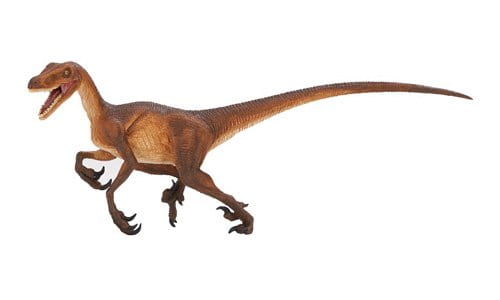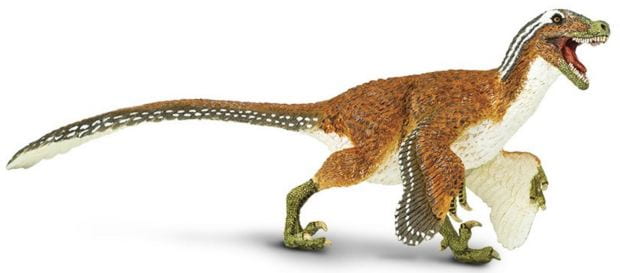Safari Ltd was established in 1982 and describes their products as “Toys that teach.” While Safari Ltd does produce lines of mythological creatures and dragons, the majority of the company’s toys are extant and extinct animals. The toys themselves are relatively simple plastic figures, but are notable in that they are hand-painted and in their detail and apparent realism. Safari Ltd adds new toys annually, and there are currently 90 figures available on the Safari Ltd website in the Prehistoric World line. Many of the figures are worth examining, but I was recently interested when I noticed two different Velociraptor figures in a local toy display.

The Velociraptor design above was released in 2008 and is still in production. The 2008 model is strikingly similar to the “Velociraptors” in the Jurassic Park films. The Velociraptors of Jurassic Park were actually more closely based on Deinonychus, a larger relative to the Velociraptor. These movie “raptors” are scaly, rather than feathered, with long forearms, and a “shrink-wrapped” appearance.

In 2017, Safari Ltd release a new feathered Velociraptor:

This model is feathered from head to tail in brown and speckled feathers, a similar coloration that we might see on a modern bird of prey. The full plumage is much more in line to what we know of the Dromaeosauridae family and help alleviate the shrink-wrapped appearance. Although the face, and particularly the mouth, are still tightened in order to emphasis the teeth and bite. The feathered model also had the outstretched forearms of the previous model.
Online, I came across this 2015 Velociraptor:

This model was a limited edition and part of the Carnegie Collection which ran from 1989 to 2015. This model is feathered from the neck to the tail. Although the face is not feathered, the Carnegie Velociraptor does appear to have more soft tissue on the face and less exaggerated teeth that the other two models. The 2015 model also has the forearms held in folded position, more akin to how a bird holds its wings. But even the Carnegie model isn’t immune to being forced to live up to the “cool” factor, sporting a red and black feathered “mohawk.”
The Velociraptor is one of the most mythologized dinosaurs in contemporary culture — second only to T. rex. Velociraptor’s image as a vicious and cunning predator can be attributed almost exclusively to the Jurassic Park films. In the 1993 film, the Velociraptors were the primary antagonists, presented as almost perfect predators: both in intelligence and physical prowess. In the more recent Jurassic World (2015), the Velociraptors have been tamed by the male protagonist, who serves as the “Alpha” of their pack (or perhaps more accurately, their flock). In both cases, the Velociraptors in particular serve an important role in portraying the masculinist expeditionary tradition associated with dinosaurs and paleontological science. The representation of Velociraptors in the Jurassic Park films warrants a separate post, but we can’t talk about Velociraptor imagery without acknowledging the role of Jurassic Park in shaping the imagery that still persists in educational children’s toys.